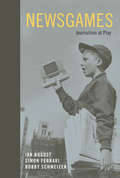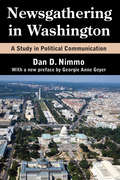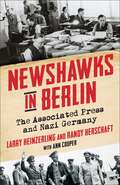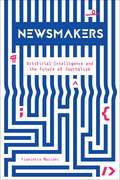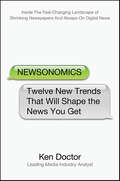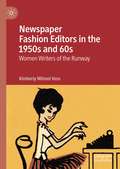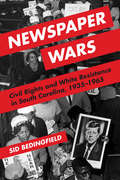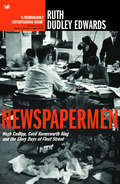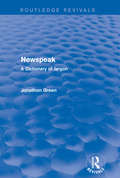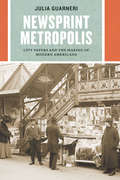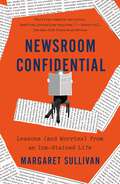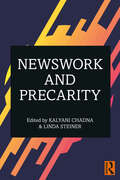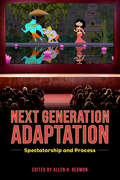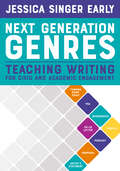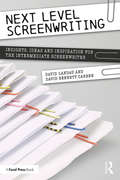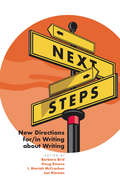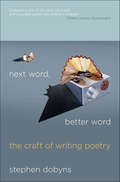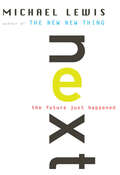- Table View
- List View
Newsgames: Journalism at Play
by Ian Bogost Simon Ferrari Bobby SchweizerHow videogames offer a new way to do journalism.Journalism has embraced digital media in its struggle to survive. But most online journalism just translates existing practices to the Web: stories are written and edited as they are for print; video and audio features are produced as they would be for television and radio. The authors of Newsgames propose a new way of doing good journalism: videogames.Videogames are native to computers rather than a digitized form of prior media. Games simulate how things work by constructing interactive models; journalism as game involves more than just revisiting old forms of news production. Wired magazine's game Cutthroat Capitalism, for example, explains the economics of Somali piracy by putting the player in command of a pirate ship, offering choices for hostage negotiation strategies.Videogames do not offer a panacea for the ills of contemporary news organizations. But if the industry embraces them as a viable method of doing journalism—not just an occasional treat for online readers—newsgames can make a valuable contribution.
Newsgathering in Washington: A Study in Political Communication
by Georgie Anne Geyer Dan NimmoIn the early twentieth century, Pulitzer Prize-winning journalist Walter Lippmann said that the presentation of truthful news lies at the heart of democracy. This volume strong strong stems from Dan D. Nimmo's conviction that opinion and policymaking are also significant, interrelated processes within any political system. A democracy poses problematic questions of the manner and means by which political ideas, opinions, and issues are transmitted throughout the body politic. In the United States, such communication is carried on primarily through the news media. Reporters and their sources interact to form crucial relationships linking citizen and official. Nimmo focuses on that interaction, using personal interviews with selected samples of Washington correspondents and their official news sources as his evidence. Nimmo's research examines the relationships that develop between news sources and reporters as each engages in political communication, indicates the factors most influential in determining such relationships, and suggests the implications such findings have for interpreting the tension that characterizes government-press relations in a democracy such as the United States. In this era of heightened attention to the role of the media in political discourse, reissuance of this volume could not be timelier. This study features a new preface by Daniel Pearl Award winner Georgie Anne Geyer. It should be read by all media specialists, communication scholars, and journalists, and will be valuable for those entering these fields as well.
Newshawks in Berlin: The Associated Press and Nazi Germany
by Larry Heinzerling Randy HerschaftAfter the Nazis came to power in Germany in 1933, the Associated Press (AP) brought news about life under the Third Reich to tens of millions of American readers. The AP was America’s most important source for foreign news, but to continue reporting under the Nazi regime the agency made both journalistic and moral compromises. Its reporters and photographers in Berlin endured onerous censorship, complied with anti-Semitic edicts, and faced accusations of spreading pro-Nazi propaganda. Yet despite restrictions, pressures, and concessions, AP’s Berlin “newshawks” provided more than a thousand U.S. newspapers with extensive coverage of the Nazi campaigns to conquer Europe and annihilate the continent’s Jews.Newshawks in Berlin reveals how the Associated Press covered Nazi Germany from its earliest days through the aftermath of World War II. Larry Heinzerling and Randy Herschaft accessed previously classified government documents; plumbed diary entries, letters, and memos; and reviewed thousands of published stories and photos to examine what the AP reported and what it left out. Their research uncovers fierce internal debates about how to report in a dictatorship, and it reveals decisions that sometimes prioritized business ambitions over journalistic ethics. The book also documents the AP’s coverage of the Holocaust and its unveiling. Featuring comprehensive research and a memorable cast of characters, this book illuminates how the dilemmas of reporting on Nazi Germany remain familiar for journalists reporting on authoritarian regimes today.
Newsletters and Press Releases: Bullet Guides
by Brian SalterOpen this book and you will - Get people's attention - Write compelling copy - Make an impact in the media - Keep your customers coming back
Newsletters and Press Releases: Bullet Guides
by Brian SalterOpen this book and you will- Get people's attention- Write compelling copy- Make an impact in the media- Keep your customers coming back
Newsmakers: Artificial Intelligence and the Future of Journalism
by Francesco MarconiWill the use of artificial intelligence (AI), algorithms, and smart machines be the end of journalism as we know it—or its savior? In Newsmakers, Francesco Marconi, who has led the development of the Associated Press and Wall Street Journal’s use of AI in journalism, offers a new perspective on the potential of these technologies. He explains how reporters, editors, and newsrooms of all sizes can take advantage of the possibilities they provide to develop new ways of telling stories and connecting with readers.Marconi analyzes the challenges and opportunities of AI through case studies ranging from financial publications using algorithms to write earnings reports to investigative reporters analyzing large data sets to outlets determining the distribution of news on social media. Newsmakers contends that AI can augment—not automate—the industry, allowing journalists to break more news more quickly while simultaneously freeing up their time for deeper analysis. Marshaling insights drawn from firsthand experience, Marconi maps a media landscape transformed by artificial intelligence for the better. In addition to considering the benefits of these new technologies, Marconi stresses the continuing need for editorial and institutional oversight. Newsmakers outlines the important questions that journalists and media organizations should consider when integrating AI and algorithms into their workflow. For journalism students as well as seasoned media professionals, Marconi’s insights provide much-needed clarity and a practical roadmap for how AI can best serve journalism.
Newsonomics: Twelve New Trends That Will Shape the News You Get
by Ken DoctorThe New NewsReports of the death of the news media are highly premature, though you wouldn't know it from the media's own headlines. Ken Doctor goes far beyond those headlines, taking an authoritative look at the fast-emerging future.The Twelve Laws of Newsonomics reveal the kinds of news that readers will get and that journalists (and citizens) will produce as we enter the first truly digital news decade. A new Digital Dozen, global powerhouses from The New York Times, News Corp, and CNN to NBC, the BBC, and NPR will dominate news across the globe, Locally, a colorful assortment of emerging news players, from Boston to San Diego, are rewriting the rules of city reporting, Newsonomics provides a new sense of the news we'll get on paper, on screen, on the phone, by blog, by podcast, and via Facebook and Twitter. It also offers a new way to understand the why and how of the changes, and where the Googles, Yahoos and Microsofts fit in. Newsonomics pays special attention to media and journalism students in a chapter on the back-to-the-future skills they'll need, while marketing professionals get their own view of what the changes mean to them.
Newspaper Fashion Editors in the 1950s and 60s: Women Writers of the Runway
by Kimberly Wilmot VossThis book documents the careers of newspaper fashion editors and details what the fashion sections included in the post-World War II years. The analysis covers social, political and economic aspects of fashion. It also addresses journalism ethics, fashion show reporting and the decline in fashion journalism editor positions.
Newspaper Journalism: A Practical Introduction
by Susan Featherstone Susan Pape'As well as guides on how to report courts and councils, Newspaper Journalism offers tips on how to write both news stories and features and how to make and keep contacts. The tips are packed with real life examples from journalists working on provincial newspapers. A worthwhile read - and not just for the latest newshound to join the press pack' - www.HoldtheFrontPage.co.uk 'This is lucid, lean and up-to-date introduction to newspaper journalism and how to do it' - Jane Taylor, The Surrey Institute of Art and Design A practical introduction to journalism, and the broader context in which journalists operate, Newspaper Journalism covers the key elements and distinctive features that constitute good newspaper journalism. Engagingly written, the book is also a rich resource of real life examples, anecdotes, case studies and exercises. Susan Pape and Susan Featherstone have drawn on their considerable experience to provide a solid grounding in the principles and practice of newspaper journalism. The resulting book recognises the needs of the profession and those seeking to enter it.
Newspaper Wars: Civil Rights and White Resistance in South Carolina, 1935-1965
by Sid BedingfieldAgainst all odds, the seeds of social change found purchase in mid-twentieth century South Carolina. Newspaperman John McCray and his allies at the Lighthouse and Informer challenged readers to "rebel and fight"--to reject the "slavery of thought and action" and become "progressive fighters" for equality. Newspaper Wars traces the role journalism played in the fight for civil rights in South Carolina from the 1930s through the 1960s. Moving the press to the center of the political action, Sid Bedingfield tells the stories of the long-overlooked men and women on the front lines of a revolution. African American progress sparked a battle to shape South Carolina's civic life, with civil rights activists arrayed against white journalists determined to preserve segregation through massive resistance. As that strategy failed, white newspapers turned to overt political action and crafted the still-prevalent narratives that aligned southern whites with the national conservative movement. A fascinating portrait of a defining time, Newspaper Wars analyzes the role journalism played--and still can play--during times of social, cultural, and political change.
Newspapermen: Hugh Cudlipp, Cecil Harmsworth King and the Glory Days of Fleet Street
by Ruth Dudley EdwardsThey were 'Cudlipp' and 'Mr King' when they met in 1935. At 21, gregarious, extrovert and irreverent Hugh Cudlipp had many years of journalistic experience: at 34, shy, introspective and solemn Cecil Harmsworth King, haunted by the ghost of Uncle Alfred, Lord Northcliffe, the great press magnate, and bitter towards Uncle Harold, Lord Rothermere of the Daily Mail, was fighting his way up in the family business. Opposites in most respects, they were complementary in talents and had in common a deep concern for the underdog. Cudlipp, the journalistic genius, and King, the formidable intellect, were to become, in Cudlipp's words, 'the Barnum and Bailey' of Fleet Street. Together, on the foundation of the populist Daily Mirror, they created the biggest publishing empire in the world. Yet their relationship foundered sensationally in 1968, when - as King tried to topple the Prime Minister - Cudlipp toppled King. Through the story of two extraordinary men, Ruth Dudley Edwards gives us a riveting portrait of Fleet Street in its heyday.
Newspeak: A Dictionary of Jargon (Routledge Revivals)
by Jonathon GreenGeorge Orwell coined the term ‘Newspeak’ for his novel 1984, the purpose of which was designed to shrink vocabularies and eliminate subtlety and nuance. For this dictionary, first published to herald the year 1984, Jonathon Green compiled nearly 8, 000 entries – selected from the slangs and specific vocabularies of trades, professions and interests – covering such areas as the world of entertainment, the media, the military economics, and finance. This dictionary provides an accurate and useful linguistic guide for students of lexicography and an interesting compendium for the general inquisitive reader.
Newsprint Metropolis: City Papers and the Making of Modern Americans
by Julia GuarneriAt the close of the nineteenth century, new printing and paper technologies fueled an expansion of the newspaper business. Newspapers soon saturated the United States, especially its cities, which were often home to more than a dozen dailies apiece. Using New York, Philadelphia, Milwaukee, and Chicago as case studies, Julia Guarneri shows how city papers became active agents in creating metropolitan spaces and distinctive urban cultures. Newsprint Metropolis offers a vivid tour of these papers, from the front to the back pages. Paying attention to much-loved features, including comic strips, sports pages, advice columns, and Sunday magazines, she tells the linked histories of newspapers and of the cities they served. Guarneri shows how themed sections for women, businessmen, sports fans, and suburbanites illustrated entire ways of life built around consumer products. But while papers provided a guide to individual upward mobility, they also fostered a climate of civic concern and responsibility. Charity campaigns and metropolitan sections painted portraits of distinctive, cohesive urban communities. Real estate sections and classified ads boosted the profile of the suburbs, expanding metropolitan areas while maintaining cities’ roles as economic and information hubs. All the while, editors were drawing in new reading audiences—women, immigrants, and working-class readers—helping to give rise to the diverse, contentious, and commercial public sphere of the twentieth century.
Newsroom Confidential: Lessons (and Worries) from an Ink-Stained Life
by Margaret Sullivan"Sullivan remains the critic American journalism requires, a veteran practitioner with street cred, still in touch with the ‘unaccountable joy’ of reporting and writing that continues to draw talented young people to the field.” —Steve Coll, The New York Times Book ReviewSullivan began her career at the Buffalo News, where she rose from summer intern to editor in chief. In Newsroom Confidential she chronicles her years in the trenches battling sexism and throwing elbows in a highly competitive newsroom. In 2012, Sullivan was appointed the public editor of The New York Times, the first woman to hold that important role. She was in the unique position of acting on behalf of readers to weigh the actions and reporting of the paper's staff, parsing potential lapses in judgment, unethical practices, and thorny journalistic issues. Sullivan recounts how she navigated the paper’s controversies, from Hillary Clinton's emails to Elon Musk's accusations of unfairness to the need for greater diversity in the newsroom. In 2016, having served the longest tenure of any public editor, Sullivan left for the Washington Post, where she had a front-row seat to the rise of Donald Trump in American media and politics.With her celebrated mixture of charm, sharp-eyed observation, and nuanced criticism, Sullivan takes us behind the scenes of the nation's most influential news outlets to explore how Americans lost trust in the news and what it will take to regain it.
Newswork and Precarity
by Linda Steiner Kalyani ChadhaThis edited collection brings together leading scholars from around the world to discuss the consequences and implications of precarious labor conditions within the modern news industry. In 14 original chapters, contributors address global concerns in journalism across all platforms, based on the assumption that unstable employment conditions affect the extent to which journalists can continue to play their historically crucial role in sustaining democracies. Topics discussed include work conditions for freelancers and entrepreneurial journalists as well as the risks facing conflict reporters, precarity in media start-ups, unionization and other collective efforts, policies regulating journalistic labor around the world, and the impact of hedge fund money on newswork. Drawing on case studies and data from South America, Africa, the United States, Canada, Mexico, the United Kingdom, and continental Europe, the book highlights how media outlets are forcing newsworkers to work harder for less money, and few countries are proactive in alleviating the precarity of journalists. Newswork and Precarity is a valuable addition to an important still-emerging area in journalism studies that will be of interest to both professionals and scholars of journalism, media studies, sociology, and labor history.
Next Generation Adaptation: Spectatorship and Process
by Allen H. RedmonContributions by Zoe Bursztajn-Illingworth, Marc DiPaolo, Emine Akkülah Doğan, Caroline Eades, Noelle Hedgcock, Tina Olsin Lent, Rashmila Maiti, Allen H. Redmon, Jack Ryan, Larry T. Shillock, Richard Vela, and Geoffrey Wilson In Next Generation Adaptation: Spectatorship and Process, editor Allen H. Redmon brings together eleven essays from a range of voices in adaptation studies. This anthology explores the political and ethical contexts of specific adaptations and, by extension, the act of adaptation itself. Grounded in questions of gender, genre, and race, these investigations focus on the ways attention to these categories renegotiates the rules of power, privilege, and principle that shape the contexts that seemingly produce and reproduce them. Contributors to the volume examine such adaptations as Quentin Tarantino’s Death Proof, Jacques Tourneur’s Out of the Past, Taylor Sheridan’s Sicario and Sicario: Day of the Soldado, Jean-Jacques Annaud’s Wolf Totem, Spike Lee’s He’s Got Game, and Jim Jarmusch’s Paterson. Each chapter considers the expansive dialogue adaptations accelerate when they realize their capacity to bring together two or more texts, two or more peoples, two or more ideologies without allowing one expression to erase another. Building on the growing trends in adaptation studies, these essays explore the ways filmic texts experienced as adaptations highlight ethical or political concerns and argue that spectators are empowered to explore implications being raised by the adaptations.
Next Generation Genres: Teaching Writing For Civic And Academic Engagement
by Jessica Singer EarlyStudents need updated writing genres, and a real reason to write. Evolutions in technology and connectivity have brought about significant changes in the ways writing is produced and shared. Yet despite monumental shifts in the practice of writing, how we teach writing has remained largely static. What we need is a new set of genres for writing instruction: genres that will speak to students who are already immersed in rich and multifaceted literacy practices through social media, gaming, and new technologies. Jessica S. Early’s Next Generation Genres provides an alternative framework for a secondary writing curriculum that places a central emphasis on helping students gain the experience they need to write with confidence in academic and civic life. If your students’ eyes glaze over when they face a standard essay assignment, perhaps it’s time to let them try writing an infographic or a podcast!
Next Level Screenwriting: Insights, Ideas and Inspiration for the Intermediate Screenwriter
by David Landau David CarrenNext Level Screenwriting is an intermediate screenwriting book, for those that have already learned the basics of screenwriting, written a screenplay or two and want to bring their writing and stories to the next level. Each chapter of the book examines a specific aspect of screenwriting, such as character, dialogue and theme, and then provides the reader with ideas, tips and inspiration to apply to their own writing. Rather than being another “how to” book, this volume features a variety of case studies and challenging exercises throughout – derived from a broad selection of successful feature films and TV shows from the 1940s to the present day – to help spark the imagination of the writer as they work through different styles and approaches of screenwriting.An absolute must-read for any screenwriter wanting to improve their writing and storytelling skills.
Next Steps with Academic Conversations: New Ideas for Improving Learning Through Classroom Talk
by Jeff ZwiersDr. Jeff Zwiers, an educational researcher at Stanford University, has spent the last 15 years analyzing classroom conversations to see how they can be better used and improved in classroom settings. Teachers who have worked with him report significant growth in students&’ engagement, content learning, language, creativity, and sense of agency. Zweirs introduced his initial vision for classroom conversations Academic Conversations: Classroom Talk that Fosters Critical Thinking and Content Understanding. His follow-up book, Next Steps with Academic Conversations: New Ideas for Improving Learning Through Classroom Talk , expands the first book with updated classroom strategies and practices. In this new version, teachers will discover: How to introduce buildable ideas and teach students how to develop and support them Equitable classroom discussions and how diverse backgrounds conversing can benefit social skills and emotional intelligence Highlights of new research-based theories on classroom conversation Ways to develop students' confidence in conversation and how classroom skills can apply to real world interactions This resource is the product of his extensive research, co-teaching, and collaborating with a wide range of educators. It was written for busy teachers who want a practical guide for strengthening the quality and quantity of productive conversations in their lessons.
Next Steps: New Directions for/in Writing about Writing
by Nancy Wilson Rebecca Jackson Elizabeth Wardle Linda Adler-Kassner Christian Smith Christina Grant Elizabeth Kleinfeld Jennifer DeWinter Rebecca Robinson Emma Gaier Megan Wallace Lisa Tremain Hiroki Sugimoto Joy Arbor Valerie Vera Gwen Hart Mysti Rudd Kristen Di Gennaro Cat Mahaffey Shawn Casey Andrew Ogilvie Olga Aksakalova Dominique Zino Andrew Lucchesi Gabriel Cutrufello Michael Michaud Sarah Read Francis Johnson Samuel Stinson Rebecca Nowacek Kimberly Hoover Elle Limesand Maggie Hammond Max Wellman Matthew Bryan Kevin Roozen Nicole Stack Christy I. Wenger Gabrielle Frick Patrick Siebel Katie Jo LaRiviereNext Steps: New Directions for/in Writing about Writing is the first collection of teacher and student voices on a writing pedagogy that puts expert knowledge at the center of the writing classroom. More than forty contributors report on implementations of writing-about-writing pedagogies from the basic writing classroom to the graduate seminar, in two-year and four-year schools, and in small colleges and research universities around the United States and the world. For more than ten years, WAW approaches have been emerging in all these sites and scenes of college writing instruction, and Next Steps offers an original look at the breadth of ways WAW pedagogy has been taken up by writing instructors and into an array of writing courses. Organized by some of the key foci of WAW instruction—writerly identity, process, and engagement—the book takes readers into thick classroom descriptions as well as vignettes offering shorter takes on particular strategies. The classroom descriptions are fleshed out in more personal ways by student vignettes, reflections on encountering writing about writing in college writing classes. As its theoretical basis, Next Steps includes chapters on threshold concepts, transfer of writing-related learning, and the history of WAW pedagogies. As the first extensive look into WAW pedagogies across courses and institutions, Next Steps is ideal for writing instructors looking for new approaches to college composition instruction or curious about what “writing about writing” pedagogy actually is, for graduate students in composition pedagogy and their faculty, and for those researching composition pedagogy, threshold concepts, and learning transfer. Contributors: Linda Adler-Kassner, Olga Aksakalova, Joy Arbor, Matthew Bryan, Shawn Casey, Gabriel Cutrufello, Jennifer deWinter, Kristen di Gennaro, Emma Gaier, Christina Grant, Gwen Hart, Kimberly Hoover, Rebecca Jackson, Frances Johnson, Elizabeth Kleinfeld, Katie Jo LaRiviere, Andrew Lucchesi, Cat Mahaffey, Michael Michaud, Rebecca S. Nowacek, Andrew Ogilvie, Sarah Read, Rebecca Robinson, Kevin Roozen, Mysti Rudd, Christian Smith, Nichole Stack, Samuel Stinson, Hiroki Sugimoto, Lisa Tremain, Valerie Vera, Megan Wallace, Elizabeth Wardle, Christy I. Wenger, Nancy Wilson, Dominique Zino
Next Word, Better Word: The Craft of Writing Poetry
by Stephen DobynsThis accessible writer's guide provides a helpful framework for creating poetry and navigates contemporary concerns and practices. Stephen Dobyns, author of the classic book on the beauty of poetry, Best Words, Best Order, moves into new terrain in this remarkable book. Bringing years of experience to bear on issues such as subject matter, the mechanics of poetry, and the revision process, Dobyns explores the complex relationship between writers and their work. From Philip Larkin to Pablo Neruda to William Butler Yeats, every chapter reveals useful lessons in these renowned poets' work. Both enlightening and encouraging, Next Word, Better Word demystifies a subtle art form and shows writers how to overcome obstacles in the creative process.
Next Year Country
by Lorney Faber"Next Year Country" is a heartwarming story -a true account-of Lomey Fa- ber's experiences on a Montana ranch. Writing with tenderness and an obvious love of nature, she describes the pleasures and hardships of a rancher's life; his pioneering spirit, often surviving on little more than faith; and his innate desire, as self-appointed guardian of the land, to preserve the environment. As the title suggests, her story is one of hope -and the promise of tomorrow. As you read it you'll share her love of the land, her appreciation of God's creation, and the joy she finds in living in harmony with nature. Perhaps you'll also be reminded that perseverance and determination can make all things possible.
Next Year in Cuba: A Cubano's Coming-of-Age in America
by Gustavo Pérez FirmatThis is a personal account of a young Cuban's departure from his native country and his assimilation of American culture and values, including marriage to an American, raising an American family, teaching at an American university....
Next-Generation Memory and Ukrainian Canadian Children’s Historical Fiction: The Seeds of Memory (Children's Literature and Culture)
by Mateusz ŚwietlickiThis is the first book monograph devoted to Anglophone Ukrainian Canadian children’s historical fiction published between 1991 and 2021. It consists of five chapters offering cross-sectional and interdisciplinary readings of 41 books – novels, novellas, picturebooks, short stories, and a graphic novel. The first three chapters focus on texts about the complex process of becoming Ukrainian Canadian, showcasing the experiences of the first two waves of Ukrainian immigration to Canada, including encounters with Indigenous Peoples and the First World War Internment. The last two chapters are devoted to the significance of the cultural memory of the Holodomor, the Great Famine of 1932-1933, and the Second World War for Ukrainian Canadians. All the chapters demonstrate the entanglements of Ukrainian and Canadian history and point to the role Anglophone children’s literature can play in preventing the symbolical seeds of memory from withering. This volume argues that reading, imagining, and reimagining history can lead to the formation of beyond-textual next-generation memory. Such memory created through reading is multidimensional as it involves the interpretation of both the present and the past by an individual whose reality has been directly or indirectly shaped by the past over which they have no influence. Next-generation memory is of anticipatory character, which means that authors of historical fiction anticipate the readers – both present-day and future – not to have direct links to any witnesses of the events they discuss and to have little knowledge of the transcultural character of the Ukrainian Canadian diaspora.
Next: The Future Just Happened
by Michael LewisThe New York Times bestseller. "His book is a wake-up call at a time when many believe the net was a flash in the pan."--BusinessWeek With his knowing eye and wicked pen, Michael Lewis reveals how the Internet boom has encouraged changes in the way we live, work, and think. In the midst of one of the greatest status revolutions in the history of the world, the Internet has become a weapon in the hands of revolutionaries. Old priesthoods are crumbling. In the new order, the amateur is king: fourteen-year-olds manipulate the stock market and nineteen-year-olds take down the music industry. Unseen forces undermine all forms of collectivism, from the family to the mass market: one black box has the power to end television as we know it, and another one may dictate significant changes in our practice of democracy. With a new afterword by the author.
